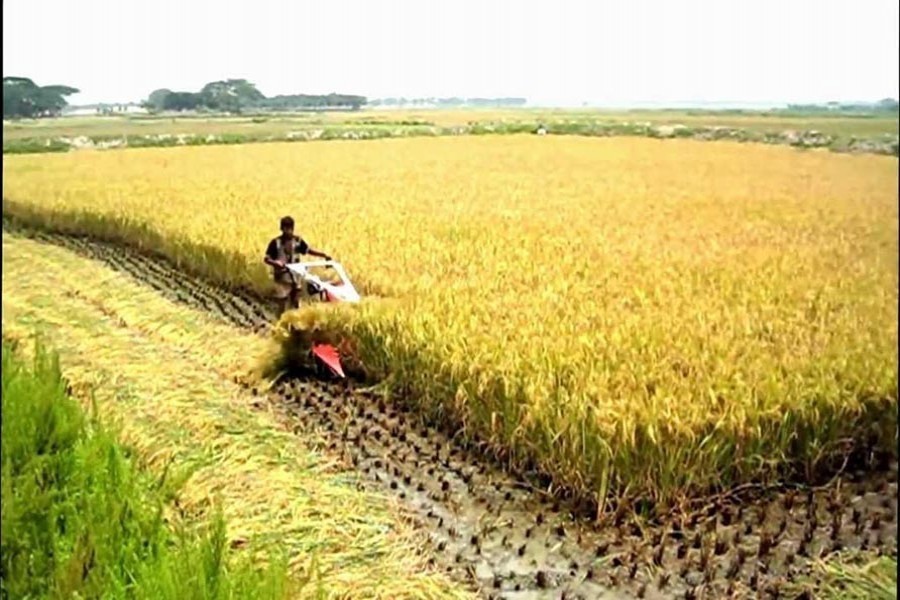Tags
Rice output to rise 45.8pc if full potential tapped
JAHIDUL ISLAM

Rice production in Bangladesh remains at 4.8 tonnes per hectare, 1.2 to 2.2 tonnes below the potential yield of 6-7 tonnes, due to constraints such as cultivation of low-yield paddy varieties, according to the final report of the taskforce on sustainable development formed by the planning ministry. Addressing the ongoing challenges would help increase rice production by up to 45.8 per cent, wheat by 66.7 per cent, maize by 34.8 per cent, jute by 42.9 per cent and potato output could be almost doubled, found an analysis of the report.
The report of the committee was submitted to the Chief Adviser of the interim government recently and the committee is scheduled to give details of it at a press conference on Monday.
“The majority of farmers in the country are cultivating crop varieties that are over 30 years old, despite numerous new varieties being developed in recent decades. Introducing these improved varieties could significantly boost agricultural production,” said Dr. KAS Murshid, Chairman of the taskforce.
He stated that the agricultural sector in the country was currently facing significant challenges, but addressing them would ensure food sufficiency, reduce import dependency, save foreign currency on food imports, and increase farmers’ income.
The taskforce found several major challenges in the agricultural sector in the country including land scarcity and fragmentation, declining labour force, and limited market access for over 70 per cent of farmers.
Mechanization remains low, with only 50 per cent of farmers using power tillers or tractors, compared to over 80% in India, the report reveals.
Additionally, many farmers struggle with access to credit and lack the necessary capital to invest in modern farming practices, it added.
To address agricultural challenges, several recommendations have been proposed by the taskforce, including adopting Axial Flow Pumps, two-wheeled mechanical reapers, and Alternate Wetting and Drying (AWD) irrigation to improve efficiency.
Expanding the use of solar-powered sprinkler irrigation can enhance water management, while investing in upgrading domestic fertilizer plants and establishing strategic fertilizer reserves can reduce import dependency, it added.
Additionally, promoting the cultivation of high-yield crop varieties will help boost overall agricultural productivity.
Introducing high yield varieties of rice could increase production by 1.2 to 2.2 tonnes per hectare, which would add an additional 46 per cent of rice, according to the report.
“Despite significant progress in rice production, Bangladesh still faces a substantial yield gap, with national average yields at 4.8 tons per hectare-1.2 to 2.2 tons below the potential 6-7 tons per hectare under optimal conditions,” reveals the report and says that the gap is even wider compared to newer high-yielding varieties. Key constraints include suboptimal farming practices, limited access to improved seeds, inadequate irrigation, and natural disasters such as floods and droughts.
Strengthening agricultural finance, extension services, irrigation infrastructure, and the adoption of climate-resilient rice varieties is crucial for closing this gap and ensuring long-term food security, it added.
Yield of potato remained at 20-25 tonnes per hectare in the country, nearly half the full potential of 40-50 tonnes, while the full utilization would help almost double the production.
Production of wheat can be increased to 4-5 tonnes per hectare of land, 1.2-2 tonnes higher than the current yield rate.
Over 70 per cent of farmers still rely on old rice varieties while shifting to high-yield varieties could significantly boost yields, said KAS Murshid.
He said that proper initiatives should be introduced to popularised the high yield varieties of crops among the farmers and also increase awareness of them.
https://thefinancialexpress.com.bd/trade/stakeholders-for-digitalised-integrated-value-chain-lower-interest-rate-for-rational-essentials-pricePublished Date: February 2, 2025






